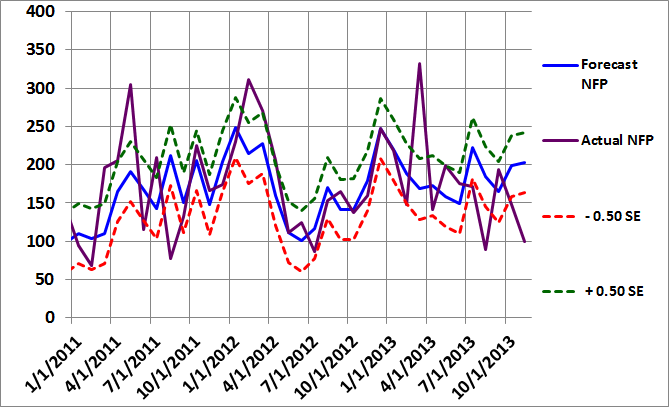This article presents the Trader Edge aggregate neural network model forecast for the October 2013 non-farm payroll data, which is scheduled to be released tomorrow morning at 8:30 AM EST.
Non-Farm Payroll (NFP) Model Forecast - October 2013
The Trader Edge aggregate NFP model represents the average of three neural network forecasting models, each of which employs a different neural network architecture. Unlike expert systems, neural networks use algorithms to identify and quantify complex relationships between variables based on historical data. All three models derive their forecasts from seven explanatory variables and the changes in those variables over time.
The table in Figure 1 below includes the monthly non-farm payroll data for two months: September and October 2013. The September data was released last month and the non-farm payroll data for October 2013 will be released tomorrow morning at 8:30 AM EST.
The model forecasts are in the third data row of the table (in blue). Note that past and current forecasts reflect the latest values of the independent variables, which means that forecasts will change when revisions are made to the historical economic data.
The monthly standard error of the model is approximately 78,900 jobs. The first and last data rows of the table report the forecast plus 0.5 standard errors (in green) and the forecast minus 0.5 standard errors (in red), respectively. All values are rounded to the nearest thousand. If the model errors were normally distributed, roughly 31% of the observations would fall below -0.5 standard errors and another 31% of the observations would exceed +0.5 standard errors.
The actual non-farm payroll release for September 2013 is in the second data row of the table (in purple). The consensus estimate (reported by Briefing.com) for October 2013 is also in the second data row of the table (in purple). The reported and consensus NFP values also include the deviation from the forecast NFP (as a multiple of the standard error of the estimate). Finally, the last column of the table includes the estimated changes from September to October 2013.
Model Commentary
The aggregate model forecast for October is 203,000, which is up 5,000 jobs from last month's revised forecast of 198,000. The Briefing.com consensus estimate for October is only 100,000, which is 48,000 lower than the September NFP release. The actual September data was below the forecast (-0.63 S.E.) and the consensus estimate for October is significantly below the model forecast (-1.30 S.E.). A consensus estimate that far below the model forecast would typically create the opportunity for a favorable (bullish) surprise tomorrow.
Unfortunately, the neural network models base their forecast on economic data, which do not fully reflect the effect of the Government shutdown on the recent non-farm payroll data. There may still be an upside surprise tomorrow, but I would not assign as much weight to the model forecasts until the effects of the Government shutdown have dissipated. The good news is that the underlying economic data continues to support stable job growth.
The February 2013 NFP data (the large, one-month spike above 300,000 in Figure 2 below) was clearly an anomaly. The NFP data had been trending lower since late last year, but has stabilized over the past few months. Unfortunately, the effects of the Government shutdown will make it more difficult to evaluate the short-term trend in the NFP data.
Summary
Basic forecasting tools can help you identify unusual consensus economic estimates, which often lead to substantial surprises and market movements. Identifying such environments may help you protect your portfolio from these corrections and help you determine the optimal entry and exit points for your strategies.
Trader Edge Strategy E-Subscription Now Available: 20% ROR
The Trader Edge Asset Allocation Rotational (AAR) Strategy is a conservative, long-only, asset allocation strategy that rotates monthly among five large asset classes. The AAR strategy has generated 20%+ annual returns over the 20+ year combined back and forward test period. Please use the above link to learn more about the AAR strategy.
Feedback
Your comments, feedback, and questions are always welcome and appreciated. Please use the comment section at the bottom of this page or send me an email.
Referrals
If you found the information on www.TraderEdge.Net helpful, please pass along the link to your friends and colleagues or share the link with your social or professional networks.
The "Share / Save" button below contains links to all major social and professional networks. If you do not see your network listed, use the down-arrow to access the entire list of networking sites.
Thank you for your support.
Brian Johnson
Copyright 2013 - Trading Insights, LLC - All Rights Reserved.














